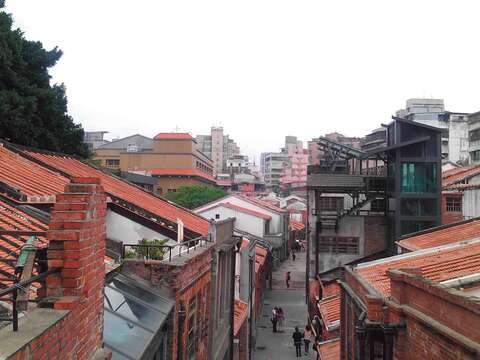Post date:2016-06-17
Updates:2016-08-23
1943
Article/Photos: Kao Chuan-chi (senior guide specializing in Taipei's historical areas)
Of Taipei City’s 12 administrative districts, Wanhua District does not cover a particularly large area; however, a deep exploration of Wanhua could require two or three days. Wanhua is the hometown of the writer. Every year, there are 50 to 60 guided outdoor activities held here. These activities cover the ecological environment, history and religion, street food, welfare for the homeless, and community building. The author conducts tours based on designated topics. Participants first attend an indoor lecture and then compare and contrast maps of the past with contemporary maps. After leaving the lecture, participants delve deeply into the community spaces and gain a new recognition of Wanhua.
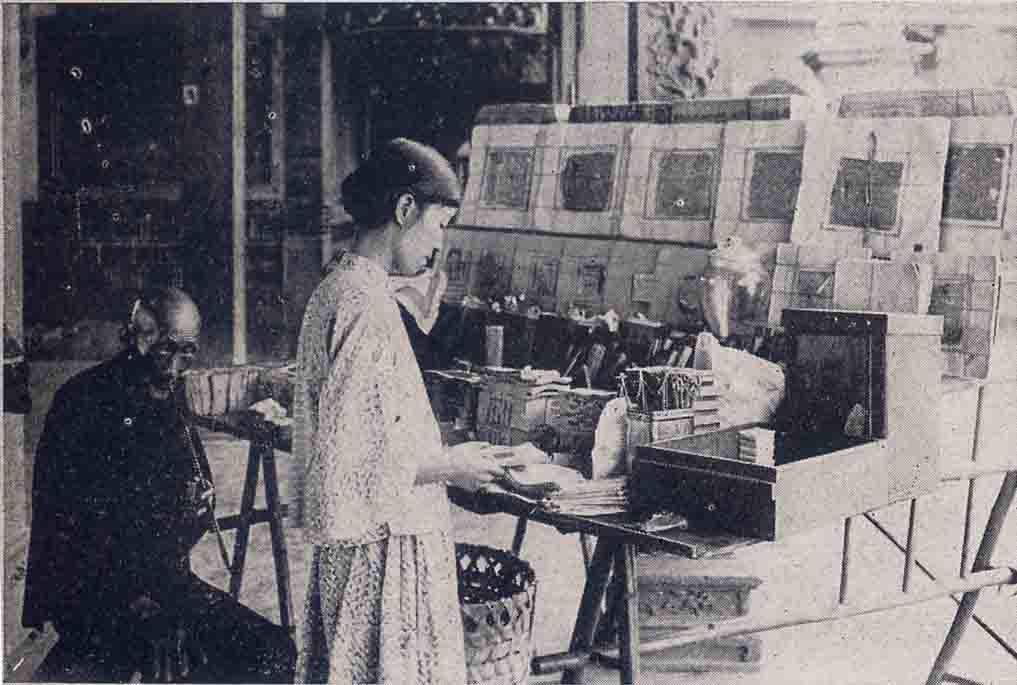
Vendors sell gold and silver paper at a temple gate in 1930s’ Bangka.
From Traditional Bangka to Contemporary Wanhua
The Bangka (Wanhua) area has experienced over 300 years of development. The community spaces can be roughly divided into the following traditional areas: Ximending in northern Wanhua, Bangka and Xiakan (下崁) in central Wanhua, and Galaya (加蚋仔) and South Airport (南機場) in the south. Each locality has its own historical context and significance. These traditional communities have been continually evolving up until the present day and have become circles of cultural life, each with its distinctive personality. For instance, Ximending is geared towards trendy youth culture and movies. Bangka is mainly centered around old street temples and eateries. Taiwan’s first officially designated industrial zone was in Xiakan (currently known for its clothing and timepiece wholesalers). Galaya was formerly an agricultural area that primarily produced fragrant crops and bamboo shoots (currently the site of Taiwan’s largest wholesale market). Finally, the South Airport was Taiwan’s first airport and its largest housing complex for military dependents. The above areas are now divided into the following subdistricts: Ximen (西門), Longshan (龍山), Dali (大理), Xiyuan (西園), Dongyuan (東園), and Qingnian (青年). Bangka was the first area to be developed in Taipei, and its prosperous businesses and literary splendor made it one of three most developed places in Taiwan, along with Tainan and Lukang, Changhua (彰化). It also served as an important political economic and cultural center in Taiwan. For nearly 300 years, this prosperous area has weathered challenges, and today Bangka’s river and harbor culture, temple architecture, old streets and alleys, and century-old shops are not only a unique part of Taiwan’s history but also remain as symbols of Bangka’s historical elegance.
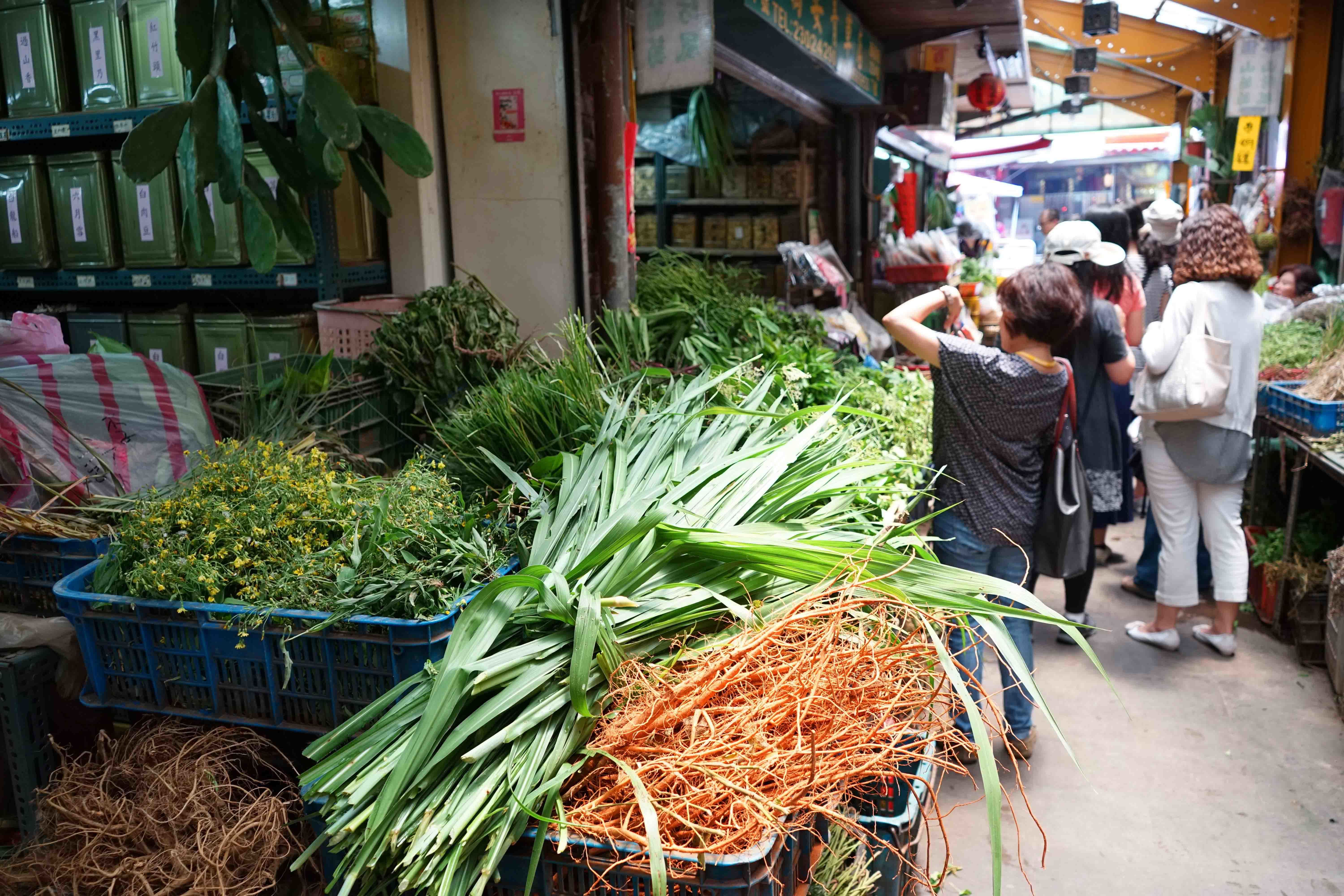
Strolling among many shops with a long history in Herb Alley is like visiting Herb Alley in ancient time. (Photo: Gao Zanxian)
Getting to Know Ancient and Modern Bangka
The history of Han Chinese cultivation of Taiwan over the past three to four hundred years can be studied from ancient maps, old photographs, and cultural and historical data left behind by residents of the past plus actual field surveys. These sources of information reveal knowledge on the following five stages: ports, temples, market streets, schools, and communities, and Bangka is naturally no exception. Early ancestors set out from the wharf on the banks of the Tamsui River and chose to begin building temples on higher ground near the riverbanks, such as Longshan Temple, Zushi Temple (祖師廟), and Qingshan Temple (青山王宮). For over a hundred years, a variety of old streets with significance related to birth and death formed in between the temples. For instance, Buddhist supplies were mainly based around Bangka Old Street; whereas golden paper industries and dowries were concentrated on Bangka New Street, and charcoal trading took place at Bopiliao. The oldest local elementary school, Laosong Elementary School (老松國小), was built on unoccupied land near the old temples and old streets during the Japanese era. In addition, public construction works, such as Wanhua Train Station and Xinfu Market (新富市場) were built one after another during this time period. Later, additional rural and urban migrants moved into what was already the bustling old Bangka, and the Fumin (富民), Fuyin (福音), and Qingshan (青山) Li that we see today took shape. In recent years because of the development of eastern city districts, Bangka has gradually lost its glamour, and experienced stagnant growth. Although the bustling prosperity of the past has faded, there are still plentiful sites, old shops, folk culture, and local life wisdom concealed within its streets. Even young people have begun creating accommodation for travelers and exhibitions, and for domestic and foreign tourists it is very much worth a visit.
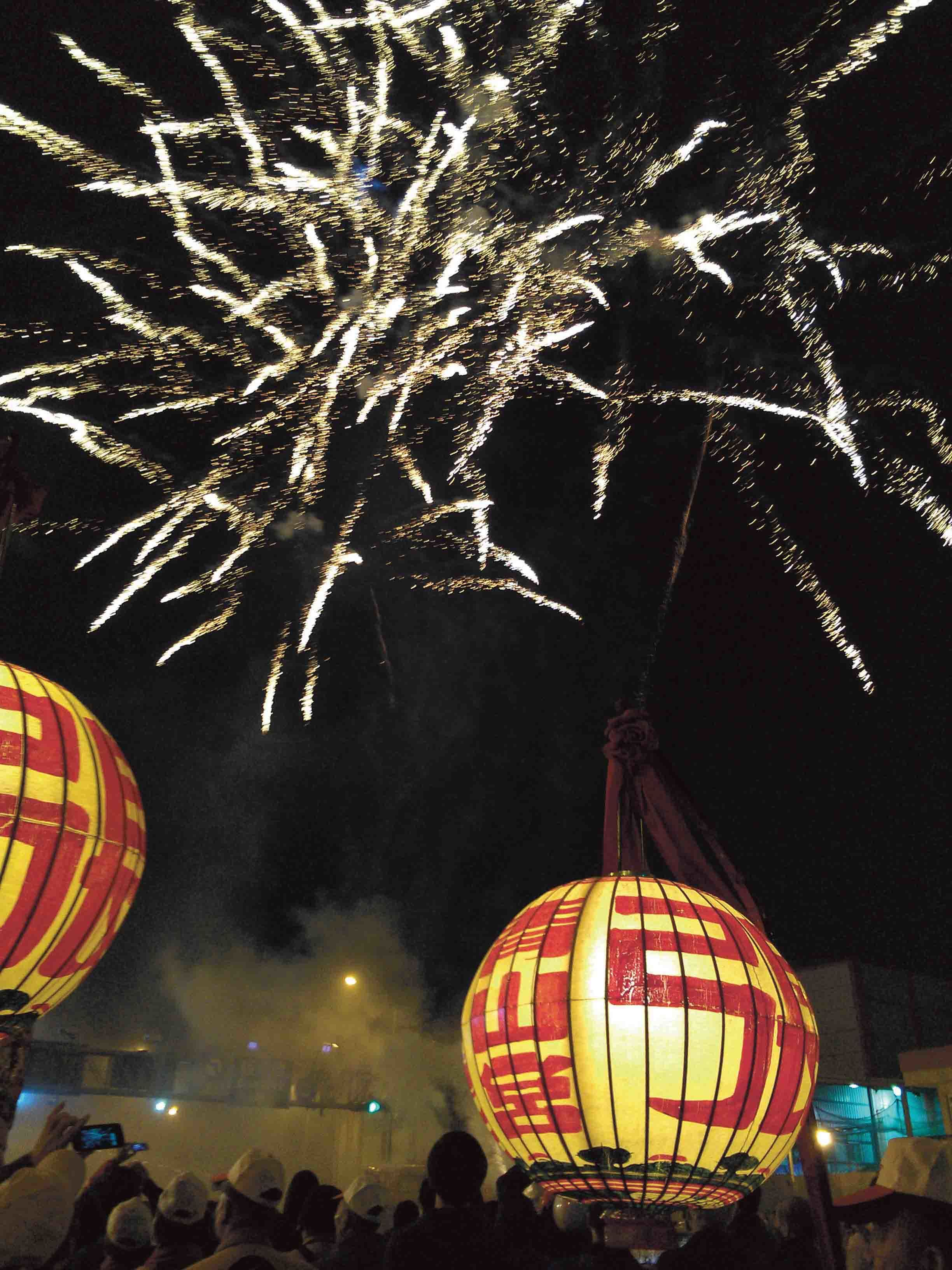
Recalling the past inspires us to cast our gaze towards Bangka’s future. Let's join hands in reengineering Bangka as a bright new spot in Taipei.
Bringing Friends Together, Bangka
Historical Tours
This year, beginning on August 29th, in addition to leading Taipei Mayor Ko Wenje on a tour of Bangka, the author organized 10 guided tours at designated times on Saturdays and Sundays. At first, there were around 30 participants per tour; later on that number increased to more than 150 participants per tour. From this experience it is possible to understand that there are many people who are eager to be led by a professional guide on an in-depth tour of a small area.
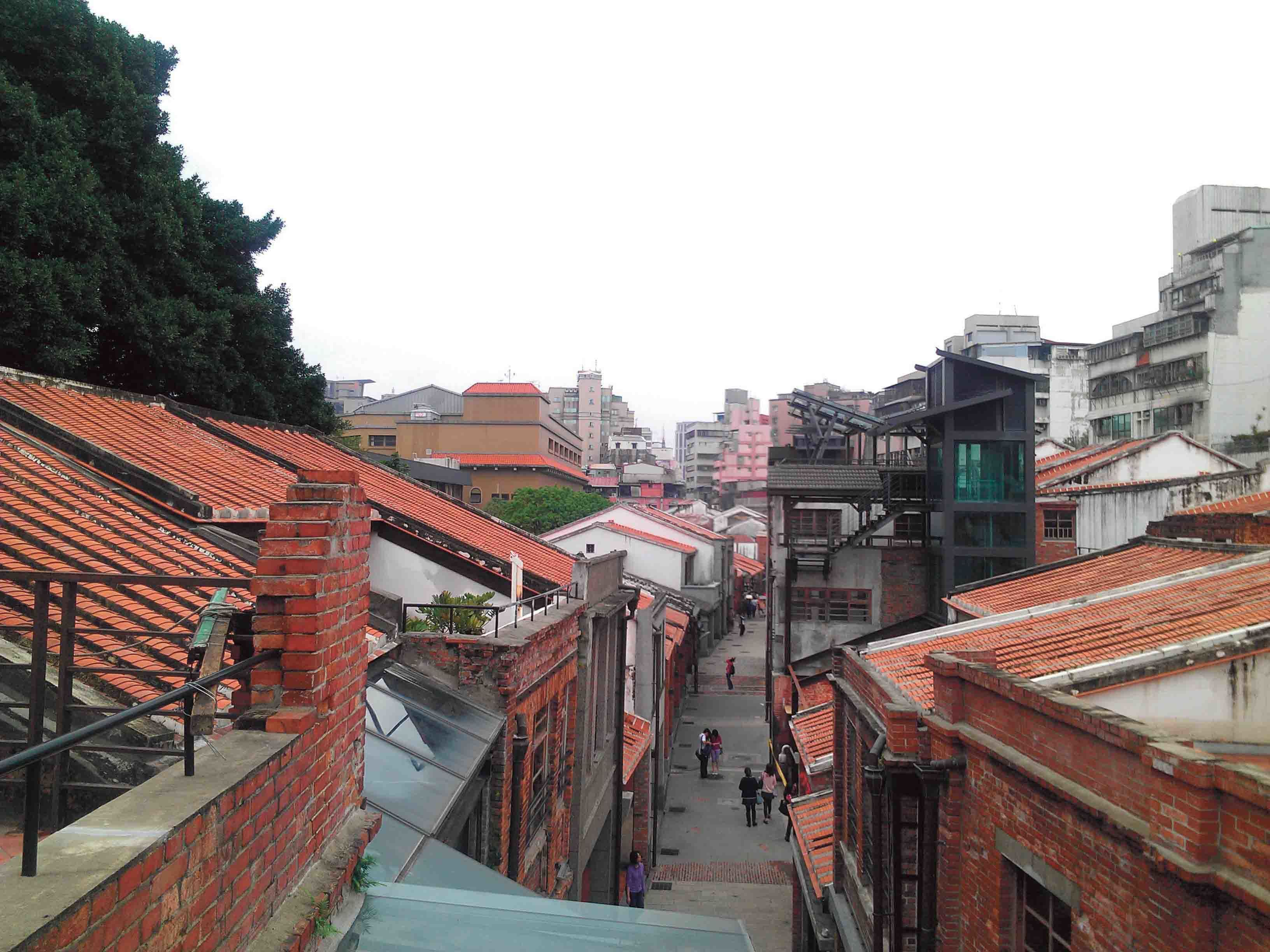
A bird’s eye view of Bopiliao Historic Block and its unique ambience.
The ten Bangka Historical Tours followed a route through famous local attractions beginning at the Longshan Temple Underground Shopping Bazaar (龍山寺地下街), and then heading to Bangka Old Street (Current Xiyuan Street), Bangka Park (艋舺公園) and Temple Courtyard Plaza (廟埕廣場), followed by the new construction at Wanhua Train Station, Longshan Temple, Herb Alley, Bangka New Street (Xichang Road), Qing Dynasty-era buildings, well known old shops on Kangding Road, Xinfu Market, Heritage and Culture Education Center of Taipei (台北鄉土教育中心), Laosong Elementary School, Bopiliao Historic Block, Qing Dynasty Bangka Fortified Gate, Huaxi Street Tourist Night Market ( 華西街觀光夜市), and finally Taipei Jen-Chi Hospital. Among the attractions listed above, there is no lack of world, Taiwan, and Taipei firsts. For example, celebrating twosixty year cycles, Laosong Elementary School is a first-rate, prestigious school. The number of students has resulted in a Guinness World Record. The Longshan Temple Underground Shopping Bazaar is the street with the highest concentration of professional fortune tellers in the world. Right now construction at the Wanhua Train station is in full swing, and when completed will hold the distinction of being the nation’s tallest railway building structure. Bopiliao Historic Block is one of the rare remaining places with more than 100 years of architectural history spanning from the Qing Dynasty to the Japanese era and the postwar era up to the 1970s. Established in the 1920s, Xinfu Market is currently one of the few remaining modernized old markets.
Led by the author, the Bangka Historical Tours are like traveling through a time tunnel back to Bangka’s golden era. The historical sights of Taiwan's hard-working ancestors appear before our eyes. However, in retrospect feelings for the past also inspire us to cast our gaze towards Bangka’s future. Let's join hands in reengineering Bangka as a bright new spot in Taipei.
Of Taipei City’s 12 administrative districts, Wanhua District does not cover a particularly large area; however, a deep exploration of Wanhua could require two or three days. Wanhua is the hometown of the writer. Every year, there are 50 to 60 guided outdoor activities held here. These activities cover the ecological environment, history and religion, street food, welfare for the homeless, and community building. The author conducts tours based on designated topics. Participants first attend an indoor lecture and then compare and contrast maps of the past with contemporary maps. After leaving the lecture, participants delve deeply into the community spaces and gain a new recognition of Wanhua.

Vendors sell gold and silver paper at a temple gate in 1930s’ Bangka.
From Traditional Bangka to Contemporary Wanhua
The Bangka (Wanhua) area has experienced over 300 years of development. The community spaces can be roughly divided into the following traditional areas: Ximending in northern Wanhua, Bangka and Xiakan (下崁) in central Wanhua, and Galaya (加蚋仔) and South Airport (南機場) in the south. Each locality has its own historical context and significance. These traditional communities have been continually evolving up until the present day and have become circles of cultural life, each with its distinctive personality. For instance, Ximending is geared towards trendy youth culture and movies. Bangka is mainly centered around old street temples and eateries. Taiwan’s first officially designated industrial zone was in Xiakan (currently known for its clothing and timepiece wholesalers). Galaya was formerly an agricultural area that primarily produced fragrant crops and bamboo shoots (currently the site of Taiwan’s largest wholesale market). Finally, the South Airport was Taiwan’s first airport and its largest housing complex for military dependents. The above areas are now divided into the following subdistricts: Ximen (西門), Longshan (龍山), Dali (大理), Xiyuan (西園), Dongyuan (東園), and Qingnian (青年). Bangka was the first area to be developed in Taipei, and its prosperous businesses and literary splendor made it one of three most developed places in Taiwan, along with Tainan and Lukang, Changhua (彰化). It also served as an important political economic and cultural center in Taiwan. For nearly 300 years, this prosperous area has weathered challenges, and today Bangka’s river and harbor culture, temple architecture, old streets and alleys, and century-old shops are not only a unique part of Taiwan’s history but also remain as symbols of Bangka’s historical elegance.

Strolling among many shops with a long history in Herb Alley is like visiting Herb Alley in ancient time. (Photo: Gao Zanxian)
Getting to Know Ancient and Modern Bangka
The history of Han Chinese cultivation of Taiwan over the past three to four hundred years can be studied from ancient maps, old photographs, and cultural and historical data left behind by residents of the past plus actual field surveys. These sources of information reveal knowledge on the following five stages: ports, temples, market streets, schools, and communities, and Bangka is naturally no exception. Early ancestors set out from the wharf on the banks of the Tamsui River and chose to begin building temples on higher ground near the riverbanks, such as Longshan Temple, Zushi Temple (祖師廟), and Qingshan Temple (青山王宮). For over a hundred years, a variety of old streets with significance related to birth and death formed in between the temples. For instance, Buddhist supplies were mainly based around Bangka Old Street; whereas golden paper industries and dowries were concentrated on Bangka New Street, and charcoal trading took place at Bopiliao. The oldest local elementary school, Laosong Elementary School (老松國小), was built on unoccupied land near the old temples and old streets during the Japanese era. In addition, public construction works, such as Wanhua Train Station and Xinfu Market (新富市場) were built one after another during this time period. Later, additional rural and urban migrants moved into what was already the bustling old Bangka, and the Fumin (富民), Fuyin (福音), and Qingshan (青山) Li that we see today took shape. In recent years because of the development of eastern city districts, Bangka has gradually lost its glamour, and experienced stagnant growth. Although the bustling prosperity of the past has faded, there are still plentiful sites, old shops, folk culture, and local life wisdom concealed within its streets. Even young people have begun creating accommodation for travelers and exhibitions, and for domestic and foreign tourists it is very much worth a visit.

Recalling the past inspires us to cast our gaze towards Bangka’s future. Let's join hands in reengineering Bangka as a bright new spot in Taipei.
Bringing Friends Together, Bangka
Historical Tours
This year, beginning on August 29th, in addition to leading Taipei Mayor Ko Wenje on a tour of Bangka, the author organized 10 guided tours at designated times on Saturdays and Sundays. At first, there were around 30 participants per tour; later on that number increased to more than 150 participants per tour. From this experience it is possible to understand that there are many people who are eager to be led by a professional guide on an in-depth tour of a small area.

A bird’s eye view of Bopiliao Historic Block and its unique ambience.
The ten Bangka Historical Tours followed a route through famous local attractions beginning at the Longshan Temple Underground Shopping Bazaar (龍山寺地下街), and then heading to Bangka Old Street (Current Xiyuan Street), Bangka Park (艋舺公園) and Temple Courtyard Plaza (廟埕廣場), followed by the new construction at Wanhua Train Station, Longshan Temple, Herb Alley, Bangka New Street (Xichang Road), Qing Dynasty-era buildings, well known old shops on Kangding Road, Xinfu Market, Heritage and Culture Education Center of Taipei (台北鄉土教育中心), Laosong Elementary School, Bopiliao Historic Block, Qing Dynasty Bangka Fortified Gate, Huaxi Street Tourist Night Market ( 華西街觀光夜市), and finally Taipei Jen-Chi Hospital. Among the attractions listed above, there is no lack of world, Taiwan, and Taipei firsts. For example, celebrating twosixty year cycles, Laosong Elementary School is a first-rate, prestigious school. The number of students has resulted in a Guinness World Record. The Longshan Temple Underground Shopping Bazaar is the street with the highest concentration of professional fortune tellers in the world. Right now construction at the Wanhua Train station is in full swing, and when completed will hold the distinction of being the nation’s tallest railway building structure. Bopiliao Historic Block is one of the rare remaining places with more than 100 years of architectural history spanning from the Qing Dynasty to the Japanese era and the postwar era up to the 1970s. Established in the 1920s, Xinfu Market is currently one of the few remaining modernized old markets.
Led by the author, the Bangka Historical Tours are like traveling through a time tunnel back to Bangka’s golden era. The historical sights of Taiwan's hard-working ancestors appear before our eyes. However, in retrospect feelings for the past also inspire us to cast our gaze towards Bangka’s future. Let's join hands in reengineering Bangka as a bright new spot in Taipei.
 TAIPEI 2015Winter Vol.02—Exploring Hometown History: Traditional Bangka and Contemporary Wanhua
TAIPEI 2015Winter Vol.02—Exploring Hometown History: Traditional Bangka and Contemporary Wanhua